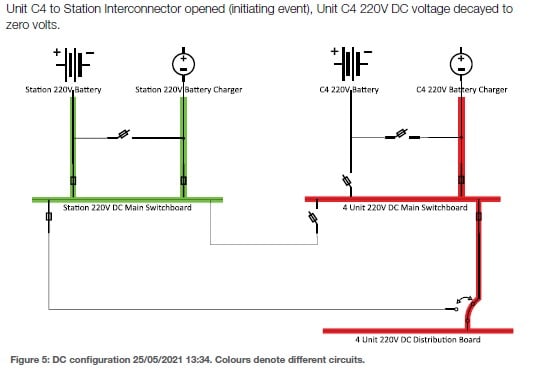-
1
- #1
thread815-483510
CS Energy has released its technical report into the 2021 C4 424MW steam powered generator failure of May 2021. At least one other independent report is expected to follow. The report is available at and includes a 20min video and a PDF.
There was a cascade of failures, but the triggering event was the collapse of the 220Vdc bus voltage at Unit C4 after the disconnection of two paralleled battery chargers. The well presented video explains that rather than sharing load, two chargers operating in parallel during commissioning, did not share load, but effectively loaded the one with a slightly higher voltage. When the two chargers were disconnected, the DC voltage from the new charger supplying the C4 unit collapsed. Pages 7 to 9 of the report list the sequence of events and include a voltage graph.
The report summary of contributing factors listed (my order):
1. A DC interlocking design that disallowed two independent batteries to be paralleled, thereby requiring chargers to be paralleled for DC redundancy
2. Battery charger/s that failed to share load when in parallel in a manner that allowed them to continue operation when separated
3. Unintended operation of "arc flap" (sic - arc flash?) protection that tripped AC to the generator auxiliary systems as a result of the DC failure
4. Failure of the DC automatic changeover switch which had been damaged 4 months earlier and presumably not been repaired
The combined AC and DC failure led to loss of lubrication oil to turbine and generator bearings and sealing oil which normally prevents hydrogen coolant from escaping. The hydrogen is believed to have combusted, the bearings failed and the generator ended up motoring at 300MW/1400Mvar until it flew apart. The Callide operators had dark SCADA system screens and were unable to determine exactly what was happening in real time.
I can't help wondering:
1. whether the 220Vdc battery chargers were designed unable to share load in parallel (which seems unusual) or whether one had a fault and
2. whether Powerlink, the transmission network operator did not see the power reversal and extraordinary reactive power flows which could have alerted them to the critical event unfolding.
CS Energy has released its technical report into the 2021 C4 424MW steam powered generator failure of May 2021. At least one other independent report is expected to follow. The report is available at and includes a 20min video and a PDF.
There was a cascade of failures, but the triggering event was the collapse of the 220Vdc bus voltage at Unit C4 after the disconnection of two paralleled battery chargers. The well presented video explains that rather than sharing load, two chargers operating in parallel during commissioning, did not share load, but effectively loaded the one with a slightly higher voltage. When the two chargers were disconnected, the DC voltage from the new charger supplying the C4 unit collapsed. Pages 7 to 9 of the report list the sequence of events and include a voltage graph.
The report summary of contributing factors listed (my order):
1. A DC interlocking design that disallowed two independent batteries to be paralleled, thereby requiring chargers to be paralleled for DC redundancy
2. Battery charger/s that failed to share load when in parallel in a manner that allowed them to continue operation when separated
3. Unintended operation of "arc flap" (sic - arc flash?) protection that tripped AC to the generator auxiliary systems as a result of the DC failure
4. Failure of the DC automatic changeover switch which had been damaged 4 months earlier and presumably not been repaired
The combined AC and DC failure led to loss of lubrication oil to turbine and generator bearings and sealing oil which normally prevents hydrogen coolant from escaping. The hydrogen is believed to have combusted, the bearings failed and the generator ended up motoring at 300MW/1400Mvar until it flew apart. The Callide operators had dark SCADA system screens and were unable to determine exactly what was happening in real time.
I can't help wondering:
1. whether the 220Vdc battery chargers were designed unable to share load in parallel (which seems unusual) or whether one had a fault and
2. whether Powerlink, the transmission network operator did not see the power reversal and extraordinary reactive power flows which could have alerted them to the critical event unfolding.

